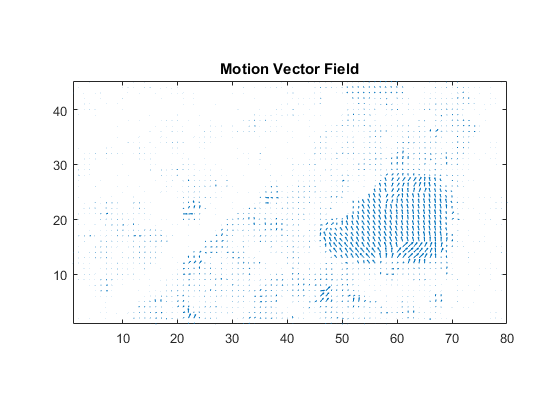Subpixel Motion Estimation without Interpolation
When I work on video processing problems one of the tasks I perform most frequently is estimating the velocity of individual pixels in a video stream. It was while solving one of these problems that I stumbled upon Stanley Chan's submission on sub-pixel motion estimation without interpolation.
Contents
Read Input Video
Let's start by reading in a video which we'll use to estimate the motion between individual pixels from frame to frame.vidReader = VideoReader('visiontraffic.avi','CurrentTime',11);
Setup Motion Estimation Parameters
We then setup the parameters for the motion estimation, in this case we set the block size to 8 and the pixel search limit to 10.
opts.BlockSize = 8; opts.SearchLimit = 10;
Estimate Motion Between First Two Frames
Now lets read the first two frames of video and and estimate the motion using the Bidirectional_ME function from the FileExchange entry.frameRGBLast = readFrame(vidReader); frameGrayLast = rgb2gray(frameRGBLast); frameRGB = readFrame(vidReader); frameGray = rgb2gray(frameRGB); [MVx, MVy] = Bidirectional_ME(im2double(frameGray), im2double(frameGrayLast)... , opts); figure; subplot(2,2,1) imagesc(MVx.^2); title('Motion Field X-Direction'); axis image; subplot(2,2,2) imagesc(MVy.^2); title('Motion Field Y-Direction'); axis image; subplot(2,2,3); imshow(frameRGBLast); title('Previous Frame'); subplot(2,2,4); imshow(frameRGB); title('Current Frame');

Quiver plot to view motion vectors
You can also view the motion vectors using a quiver plot.figure; quiver(MVx(end:-1:1,:), MVy(end:-1:1,:)); axis image; title('Motion Vector Field');
Other motion estimation techniques
The Computer Vision System Toolbox provides several other ways to do motion estimation include some variants of optical flow and block matching. To learn more typedoc vision
- Category:
- Picks
 Cleve’s Corner: Cleve Moler on Mathematics and Computing
Cleve’s Corner: Cleve Moler on Mathematics and Computing The MATLAB Blog
The MATLAB Blog Guy on Simulink
Guy on Simulink MATLAB Community
MATLAB Community Artificial Intelligence
Artificial Intelligence Developer Zone
Developer Zone Stuart’s MATLAB Videos
Stuart’s MATLAB Videos Behind the Headlines
Behind the Headlines File Exchange Pick of the Week
File Exchange Pick of the Week Hans on IoT
Hans on IoT Student Lounge
Student Lounge MATLAB ユーザーコミュニティー
MATLAB ユーザーコミュニティー Startups, Accelerators, & Entrepreneurs
Startups, Accelerators, & Entrepreneurs Autonomous Systems
Autonomous Systems Quantitative Finance
Quantitative Finance MATLAB Graphics and App Building
MATLAB Graphics and App Building









Comments
To leave a comment, please click here to sign in to your MathWorks Account or create a new one.